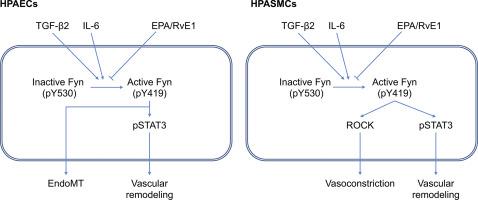Journal of Molecular and Cellular Cardiology ( IF 4.9 ) Pub Date : 2020-09-02 , DOI: 10.1016/j.yjmcc.2020.08.013 Lin Hai Kurahara 1 , Keizo Hiraishi 1 , Aya Yamamura 2 , Ying Zhang 3 , Kohtaro Abe 4 , Eiji Yahiro 5 , Mikiko Aoki 6 , Kaori Koga 6 , Hiroyasu Yokomise 7 , Tetsuhiko Go 7 , Kaori Ishikawa 8 , Zhang Bo 9 , Hiroko Kishi 3 , Sei Kobayashi 3 , Narumi Aoki-Shoi 10 , Satoh Toru 11 , Ryuji Inoue 12 , Katsuya Hirano 13

|
Pulmonary arterial hypertension (PAH) is a multifactorial disease characterized by pulmonary arterial vasoconstriction and remodeling. Src family tyrosine kinases, including Fyn, play critical roles in vascular remodeling via the inhibition of STAT3 signaling. EPA is known to inhibit Fyn kinase activity.
This study investigated the therapeutic potential and underlying mechanisms of EPA and its metabolite, resolvin E1 (RvE1), to treat PAH using monocrotaline-induced PAH model rats (MCT-PAH), human pulmonary artery endothelial cells (HPAECs), and human pulmonary artery smooth muscle cells (HPASMCs).
Administration of EPA 1 and 2 weeks after MCT injection both ameliorated right ventricular hypertrophy, remodeling and dysfunction, and medial wall thickening of the pulmonary arteries and prolonged survival in MCT-PAH rats. EPA attenuated the enhanced contractile response to 5-hydroxytryptamine in isolated pulmonary arteries of MCT-PAH rats. Mechanistically, the treatment with EPA and RvE1 or the introduction of dominant-negative Fyn prevented TGF-β2-induced endothelial-to-mesenchymal transition and IL-6-induced phosphorylation of STAT3 in cultured HPAECs. EPA and RvE1 suppressed Src family kinases' activity as evaluated by their phosphorylation status in cultured HPAECs and HPASMCs. EPA and RvE1 suppressed vasocontraction of rat and human PA. Furthermore, EPA and RvE1 inhibited the enhanced proliferation and activity of Src family kinases in HPASMCs derived from patients with idiopathic PAH. EPA ameliorated PAH's pathophysiology by mitigating vascular remodeling and vasoconstriction, probably inhibiting Src family kinases, especially Fyn. Thus, EPA is considered a potent therapeutic agent for the treatment of PAH.
中文翻译:

二十碳五烯酸通过抑制酪氨酸激酶 Fyn 改善肺动脉高压。
肺动脉高压(PAH)是一种以肺动脉血管收缩和重塑为特征的多因素疾病。Src 家族酪氨酸激酶,包括 Fyn,通过抑制 STAT3 信号传导在血管重塑中发挥关键作用。已知EPA抑制Fyn激酶活性。
本研究调查了 EPA 及其代谢物 Resolvin E1 (RvE1) 使用野百合碱诱导的 PAH 模型大鼠 (MCT-PAH)、人肺动脉内皮细胞 (HPAEC) 和人肺动脉治疗 PAH 的治疗潜力和潜在机制。平滑肌细胞 (HPASMC)。
在 MCT-PAH 大鼠中,在 MCT 注射后 1 周和 2 周施用 EPA 均改善了右心室肥厚、重塑和功能障碍以及肺动脉内壁增厚并延长了生存期。EPA 减弱了 MCT-PAH 大鼠离体肺动脉对 5-羟色胺的增强收缩反应。从机制上讲,用 EPA 和 RvE1 处理或引入显性失活 Fyn 可阻止 TGF-β2 诱导的内皮细胞向间充质转化和 IL-6 诱导的培养的 HPAEC 中 STAT3 的磷酸化。EPA 和 RvE1 抑制了 Src 家族激酶的活性,正如它们在培养的 HPAECs 和 HPASMCs 中的磷酸化状态所评估的那样。EPA 和 RvE1 抑制大鼠和人类 PA 的血管收缩。此外,EPA 和 RvE1 抑制源自特发性 PAH 患者的 HPASMC 中 Src 家族激酶的增殖和活性增强。EPA 通过减轻血管重塑和血管收缩来改善 PAH 的病理生理,可能抑制 Src 家族激酶,尤其是 Fyn。因此,EPA 被认为是治疗 PAH 的有效治疗剂。











































 京公网安备 11010802027423号
京公网安备 11010802027423号